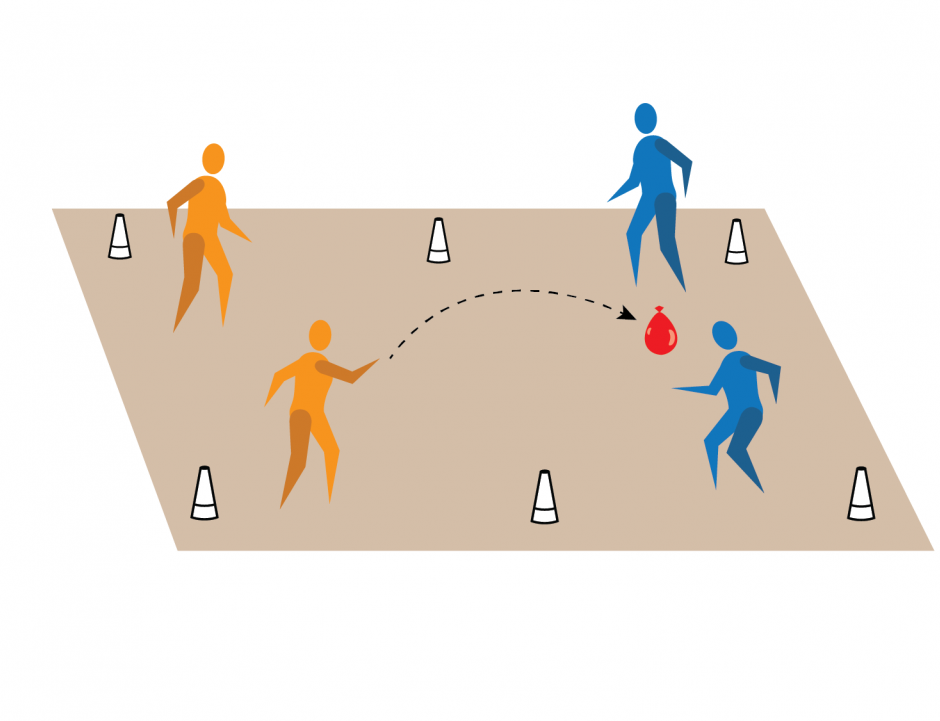TGfU Category: Net/Wall Games
Locations: gymnasium, multipurpose room, outdoor space (e.g., field, tarmac)
Game/Sport Connections
Net/Wall games are activities in which players send an object toward a court or target area that an opponent is defending. The aim is to cause the object to land in the target area while making it difficult for the opponent to return the object. By playing these games, participants develop skills and tactics to play other net/wall games or games that require the application of similar skills, concepts, and strategies (e.g., sitting volleyball, tennis, badminton, squash, racquet ball, volleyball, Sepak Takraw, wheelchair tennis).
Activity Overview
Participants learn about and practise working as a group to sustain a rally by sending and receiving an object.
Key Movement Skills, Concepts, and Strategies
Throughout the activity, consider highlighting the following skills, concepts, and strategies to help participants send and receive an object to effectively create a rally. Note that this is not an exhaustive list and further learning opportunities may arise during the task.
Movement Skills and Concepts
- Locomotion and relationship: knowing where to move to be successful at sending and receiving the object with a partner (e.g., moving toward the back of the court when the object is coming in from a height).
- Manipulation skills and effort awareness: applying a controlled force to the object (e.g., being able to control how forcefully the arm swings when sending the object to maintain a rally).
Movement Strategies
- Tactical awareness: developing an understanding of the principles of play (e.g., knowing where and how to send and receive the object to maintain a successful rally).
- Performance: demonstrating appropriate skills, techniques, and tactics to send and receive the object (e.g., hitting the object with the right amount of force to make it easy for the opponent to receive it).
Considerations
- Incorporate some or all the variations listed in the “Variations” section while planning the activity. This will help to best meet the diverse backgrounds, identities, needs, and interests of participants and maximize the fun, inclusion, participation, and success of everyone.
- To elevate participant voice and choice, periodically pause the activity and share the variations with participants. Ask them to determine how they would like to change the activity to maximize the fun, inclusion, meaningful participation, and success for everyone. Encourage participants to add any variations of their own.
Equipment
- 1 balloon to send per group
- 6 pylons per group
Safety
- Inspect the equipment and activity area to identify and remove hazards. Check that the activity surface provides sufficient traction.
- Establish the boundaries for the designated playing area at a safe distance from walls and obstacles. Share the boundaries with participants.
- Review the safety rules and activity instructions with participants prior to the activity.
- Instruct participants to be aware of their surroundings, including the locations of other participants during play.
How to Play
- Divide participants into groups of 4. This activity may also be played in pairs.
- Groups further divide into pairs.
- Assign groups a designated playing area. Groups create a square in their designated playing area, using 4 pylons to mark the corners of the square. Participants divide their square in half using 2 pylons to mark the centre line. This is the court and the centre pylons act as the “net.” Participants may increase or decrease the size of the playing area at any point during play, being mindful of other participants’ designated playing areas.
- One pair starts the game by sending (e.g., underhand, overhand, volley, bump) the balloon into the opponent’s court. Groups may choose to catch the balloon before sending it back and before attempting to rally without catching it.
- The receiving team sends the balloon back to the other side of the court.
- Groups work together to keep the balloon in the air to maintain a rally, keeping track of the number of times the balloon is passed between sides.
- If the balloon hits the ground or goes out of bounds, the group starts the rally again and tries to increase the number of successful passes.
- After a period of play, provide participants with some or all of the variations. Ask them to decide how they might change the game to enhance their fun, challenge, and success. Encourage participants to add any variations of their own.
- Consider having groups share their variations and select another variation to try with their group.
Image: Visual Depiction of the Activity Instructions

Pause for Learning
Throughout the activity, ask open-ended questions to help participants refine their movement skills, strategies, and tactical solutions. Examples include:
- When sending the balloon with your hand, where does your hand have to face if you want it to go toward your opponent?
- Describe the force you use to successfully send the balloon to your opponent.
- When getting ready to receive the balloon, how do you position your body?
- Which games or sports have you played or know about that use similar rules and strategies to the ones used in this game?
Variations
- Remove the court boundaries and change the objective of the game to keeping the balloon in the air.
- Use a beach ball instead of a balloon. Participants decide whether to allow bounces.


